A Review on Magnetorheological Jet Polishing Technique for Microstructured Functional Surfaces
Abstract
1. Introduction
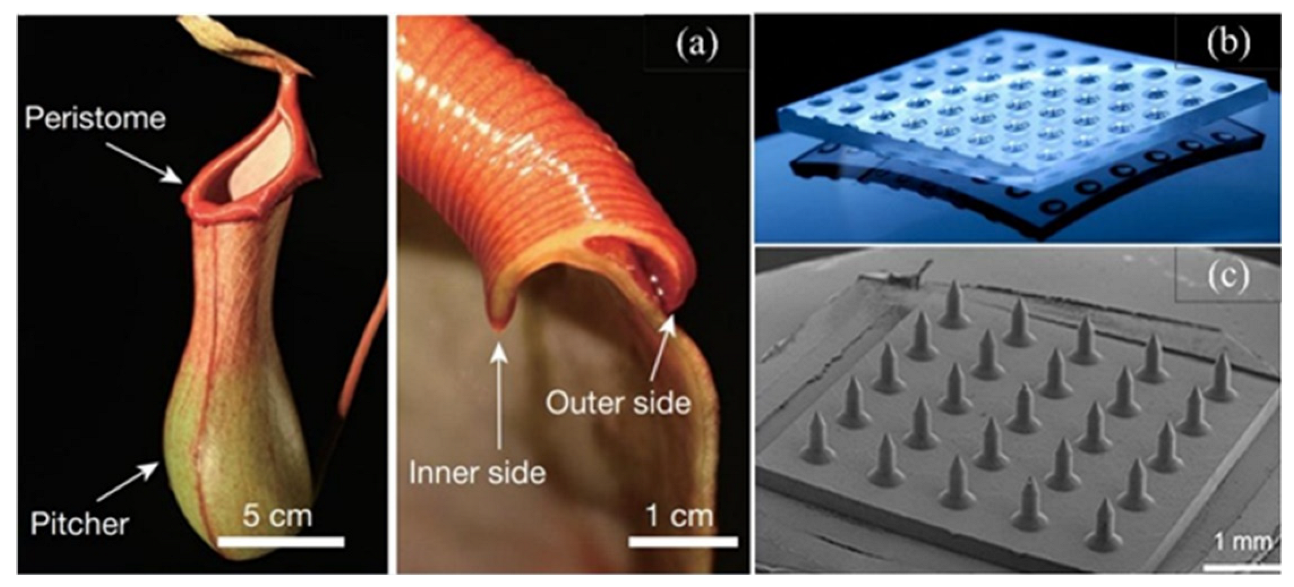
2. Machining Mechanism of MJP Polishing Technique
2.1. Principle of MJP
2.2. Materials Removal Mechanism
- (1)
- In the wall jet area, the tensile strength of the material is much smaller than the compressive strength of the material. Therefore, when the fluid flows on the wall, the impact angle of the particles along the wall to the workpiece surface decreases from the center, and the radial velocity rapidly increases to the maximum and then decreases gradually along the streamline. Low impact angle and high radial velocity can produce maximum micro-cutting efficiency, resulting in a W-shaped material removal profile [52,53]. From the microscopic removal process, when the fluid flows over the workpiece surface, as shown in Figure 4a,b, the peak of the rough surface is first contacted by the abrasive, as shown in Figure 4c. Abrasive contact with the bottom of the rough surface is a very low probability; therefore, the peak is removed first and then layer by layer cutting, which is the main reason for the roughness reduction after polishing.
- (2)
- In the central area, a small amount of material is removed when the workpiece surface is impacted by the jet fluid. The impact process can be described as the effect of the fluid on the normal pressure of the surface, the distribution of which is a predictable function of position and does not vary with time. Under impact, the surface of the workpiece forms fragments and peels off, and the removal of material is random. In the macroscopic expression, a small amount of material can be removed, which is why the removal rate of the impact zone is not zero in the actual polishing results. This random removal process of the workpiece surface has a low removal efficiency but has a great impact on the roughness [53].
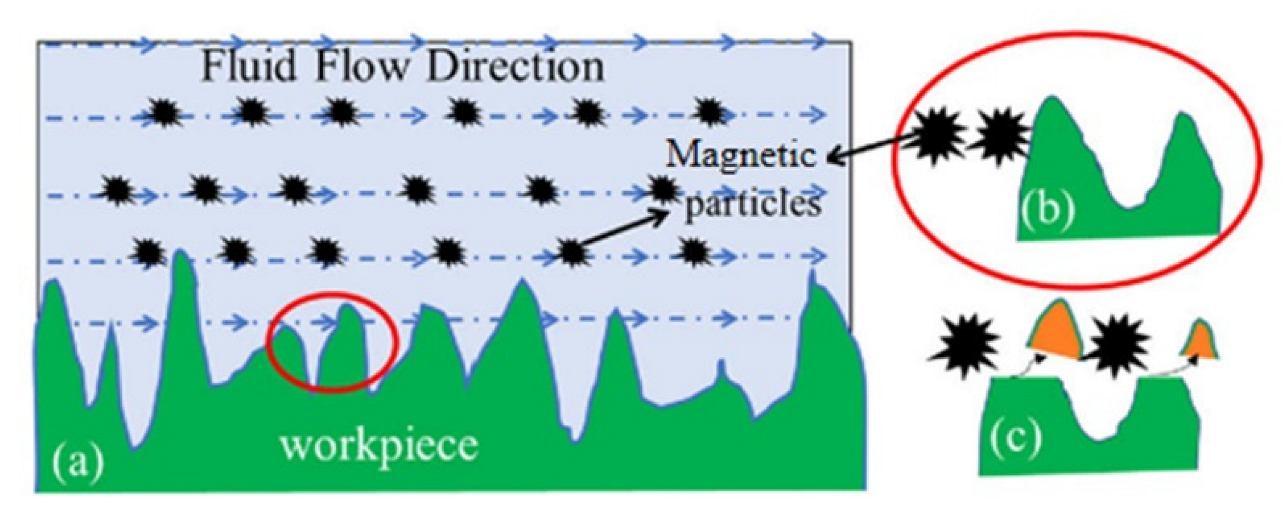
2.3. Rheological Characteristics Analysis of MR Fluid
2.4. Material Removal Model
3. MJP Processing System
3.1. Design and Analysis of Magnetic Field
3.2. Optimization of the Nozzle Structure
3.3. Circulating Stirring System
3.4. On–Line Monitoring of MR Fluid
3.5. The Special MJP System
4. Study on MJP Processing Technique
4.1. The Jet Direction
4.2. Effect of Incident Angle on Material Removal Rate
- (1)
- The velocity distribution cloud diagram and pressure distribution cloud diagram of vertical incidence are shown in Figure 16. ① After reaching the surface of the workpiece, the velocity in the center area of the fluid decreases to 0. In the process of diffusion, as a form of shear flow with a large concentration, the liquid does not spatter in the X direction but always flows on the surface of the workpiece. This is different from the flow state in abrasive jet polishing. ② During diffusion, the velocity rapidly increases to the maximum and then decreases due to the presence of shear force. However, the effective polishing area is only less than 20 mm, and in such a small area, the velocity approximately maintains the maximum value. The pressure action area is small and the distribution form is more symmetrical. In summary, the pressure on the workpiece surface presents a circular distribution. The center of the circle is the central area of the magnetic jet collision, and the diameter is about the distance of three to four nozzles. The pressure distribution form of the fluid on the workpiece is similar to the Gaussian shape distribution, and the pressure in the middle area is high and decreases in the radial direction [51].
- (2)
- The velocity distribution cloud diagram and pressure distribution cloud diagram for oblique incidence are shown in Figure 17. ① In terms of distribution form, the force on the workpiece surface is asymmetric; in terms of fluid flow, the incident angle is the obtuse angle, and the flow is larger. ② Of the removal effect on the workpiece surface, when the flow is larger, the speed is large, and the pressure is large, which leads to the result of a high removal rate. Due to the obtuse incidence removal function, the obtuse angle removal is going to be a little bit more efficient [51].
- (3)
- The positive pressure curve is analyzed, as shown in Figure 18. ① The pressure and shear force in the acute angle area changes faster. ② Compared with the distribution at normal incidence, the whole function shows a slanted Gaussian-like shape. The maximum pressure distribution is still in the corresponding position of the jet center. ③ The shear force form is very different from the vertical incidence, as shown in Figure 19. The asymmetric form is manifested to a large extent, and the shear force has a significant influence on the removal of the workpiece.
4.3. Relationship between Jet Velocity and Removal Rate
4.4. Path Programming
4.5. Effect of Processing Technique
5. Conclusions
- (1)
- The stability and efficiency of the removal function need to be studied urgently. For large diameter or more complex surfaces, the processing cycle is often very long, needs longer continuous working time, better stability of magnetic jet fluid, and polishing equipment to meet the requirements of high certainty and high-efficiency polishing. To derive a more accurate material removal function, it is necessary to deeply study the properties of polishing fluid with rheological effect, to solve the problem of fluctuation of polishing fluid composition concentration and rheological properties during the polishing process, and to realize the stability and controllability of polishing fluid rheological properties such as viscosity and hardness by controlling the auxiliary field. Based on theoretical and simulation tests, we will further study the removal mechanism of workpiece materials and optimize the polishing fluid configuration and polishing parameters according to the physicochemical characteristics of different materials.
- (2)
- New techniques and new principles of magnetorheological jet polishing still need to be developed. At present, it is urgent to develop a composite machining method, such as one combined with ultrasonic vibration machining to solve the problem of the low removal rate and low machining efficiency of magnetic jet polishing.
- (3)
- Deterministic removal model for magnetorheological jet polishing needs to be established. The current research is based on the Preston equation, which divides the pressure on the workpiece into several parts, calculates them separately, and then superposes them. When the material removal model is established, it is simply considered from the two-dimensional direction, without the in-depth consideration of the model from the three-dimensional direction. It is necessary to adopt a reasonable magnetic jet hydrodynamic model to establish a universal and unified deterministic removal model system to adapt to the processing of various profiles.
- (4)
- The process needs to be modified and accurately controlled. Based on completely determining the removal function and the correction function, the algorithm relationship between the removal function and the correction function must be taken into account to control the various movements of the nozzle to achieve the removal of the determined quantity, and a reasonable algorithm of the material removal rate and dwell time should be adopted. To achieve high precision and surface integrity machining of product parts, in addition to accurate material removal functions/models, there is an urgent need to propose more accurate polishing removal dwell time algorithms and path planning functions to achieve the controllable removal of points, lines, and surfaces in order to improve the accuracy of workpiece detection during polishing, to effectively reflect the changes in workpiece surface morphology and material removal during the polishing process, and to accurately characterize the material removal distribution in the processing area.
- (5)
- The online inspection technique machining process needs to be improved. MJP machining workpiece surface measurement is currently mainly on the workpiece after processing offline detection, which will affect the efficiency of processing, automatic compensation accuracy, and workpiece surface quality to a certain extent. Therefore, the development of the MJP online detection and automatic compensation processing technique is also one of the key issues [100].
Author Contributions
Funding
Data Availability Statement
Conflicts of Interest
References
- Brinksmeier, E.; Gläbe, R.; Schönemann, L. Review on diamond-machining processes for the generation of functional surface structures. Cirp J. Manuf. Sci. Technol. 2012, 5, 1–7. [Google Scholar] [CrossRef]
- Evans, C.J.; Bryan, J.B. “Structured” “Textured” or “Engineered” surface. CIRP Ann. 1999, 48, 541–556. [Google Scholar] [CrossRef]
- Bruzzone, A.; Costa, H.; Lonardo, P.; Lucca, D. Advances in engineered surfaces for functional performance. CIRP Ann. 2008, 57, 750–769. [Google Scholar] [CrossRef]
- Zhang, S.; Zhou, Y.; Zhang, H.; Xiong, Z.; To, S. Advances in ultra-precision machining of micro-structured functional surfaces and their typical applications. Int. J. Mach. Tools Manuf. 2019, 142, 16–41. [Google Scholar] [CrossRef]
- Alzahrani, M.; Ahmed, A.; Shanks, K.; Sundaram, S.; Mallick, T. Optical losses and durability of flawed Fresnel lenses for concentrated photovoltaic application. Mater. Lett. 2020, 275, 128145. [Google Scholar] [CrossRef]
- Tan, N.Y.J.; Zhang, X.; Neo, D.W.K.; Huang, R.; Liu, K.; Kumar, A.S. A review of recent advances in fabrication of optical Fresnel lenses. J. Manuf. Processes 2021, 71, 113–133. [Google Scholar] [CrossRef]
- Wang, Y.; Zhou, L.; Zhang, Y.; Yu, J.; Huang, B.; Wang, Y.; Lai, Y.; Zhu, S.; Zhu, J. Hybrid Solar Absorber–Emitter by Coherence-Enhanced Absorption for Improved Solar Thermophotovoltaic Conversion. Adv. Opt. Mater. 2018, 6, 1800813. [Google Scholar] [CrossRef]
- Cui, P.; Wang, S. Application of microfluidic chip technique in pharmaceutical analysis: A review. J. Pharm. Anal. 2019, 9, 238–247. [Google Scholar] [CrossRef]
- Zhao, Y.; Hu, X.-G.; Hu, S.; Peng, Y. Applications of fiber-optic biochemical sensor in microfluidic chips: A review. Biosens. Bioelectron. 2020, 166, 112447. [Google Scholar] [CrossRef]
- Cai, Y.; Luo, X.; Liu, Z.; Qin, Y.; Chang, W.; Sun, Y. Product and process fingerprint for nanosecond pulsed laser ablated superhydrophobic surface. Micromachines 2019, 10, 177. [Google Scholar] [CrossRef]
- Thaweskulchai, T.; Schulte, A. A low-cost 3-in-1 3D printer as a tool for the fabrication of flow-through channels of microfluidic systems. Micromachines 2021, 12, 947. [Google Scholar] [CrossRef] [PubMed]
- Wang, J.-N.; Bai, B.; Chen, Q.-D.; Sun, H.-B. Active Surface with Dynamic Microstructures and Hierarchical Gradient Enabled by in situ Pneumatic Control. Micromachines 2020, 11, 992. [Google Scholar] [CrossRef] [PubMed]
- Wu, M.; Kumar Saxena, K.; Guo, Z.; Qian, J.; Reynaerts, D. Fast Fabrication of Complex Surficial Micro-Features Using Sequential Lithography and Jet Electrochemical Machining. Micromachines 2020, 11, 948. [Google Scholar] [CrossRef] [PubMed]
- Kumar, A.; Kumar, M.; Alok, A.; Yadav, H.; Das, M. Fabrication of microtool for micromachining: A review. Mater. Today Proc. 2021, 47, 3911–3918. [Google Scholar] [CrossRef]
- Tilli, M.; Paulasto-Krockel, M.; Petzold, M.; Theuss, H.; Motooka, T.; Lindroos, V. Handbook of Silicon Based MEMS Materials and Technologies; Elsevier: Amsterdam, The Netherlands, 2020. [Google Scholar]
- Hsieh, C.-C.; Yao, S.-C. Evaporative heat transfer characteristics of a water spray on micro-structured silicon surfaces. Int. J. Heat Mass Transf. 2006, 49, 962–974. [Google Scholar] [CrossRef]
- Rao, K.; Wei, X.; Zhang, S.; Zhang, M.; Hu, C.; Liu, H.; Tu, L.-C. A MEMS micro-g capacitive accelerometer based on through-silicon-wafer-etching process. Micromachines 2019, 10, 380. [Google Scholar] [CrossRef]
- Burek, M.J.; Greer, J.R. Fabrication and microstructure control of nanoscale mechanical testing specimens via electron beam lithography and electroplating. Nano Lett. 2010, 10, 69–76. [Google Scholar] [CrossRef]
- Brousseau, E.; Dimov, S.S.; Pham, D.T. Some recent advances in multi-material micro-and nano-manufacturing. Int. J. Adv. Manuf. Technol. 2010, 47, 161–180. [Google Scholar] [CrossRef]
- Chen, H.; Zhang, P.; Zhang, L.; Liu, H.; Jiang, Y.; Zhang, D.; Han, Z.; Jiang, L. Continuous directional water transport on the peristome surface of Nepenthes alata. Nature 2016, 532, 85–89. [Google Scholar] [CrossRef]
- Application and Manufacturing Technique of Microlens Array. Available online: http://welloptics.b2b.huangye88.com/product_15038062.html (accessed on 25 April 2022).
- Jung, K.M.; Chan, P.S.; Binod, R.; Giselle, G.; Seung-Ki, B.; Jung-Hwan, P.; Betz, A.R.; Seong-O, C. Fabrication of Circular Obelisk-Type Multilayer Microneedles Using Micro-Milling and Spray Deposition. Front. Bioeng. Biotechnol. 2018, 6, 54. [Google Scholar]
- Hensleigh, R.M.; Cui, H.; Oakdale, J.S.; Jianchao, C.Y.; Campbell, P.G.; Duoss, E.B.; Spadaccini, C.M.; Zheng, X.; Worsley, M.A. Additive manufacturing of complex micro-architected graphene aerogels. Mater. Horiz. 2018, 5, 1035–1041. [Google Scholar] [CrossRef]
- Mizutani, M. High value manufacturing as the next frontier of nano-precision mechanical manufacturing technique. Seimitsu Kogaku Kaishi/J. Jpn. Soc. Precis. Eng. 2018, 84, 840–844. [Google Scholar] [CrossRef][Green Version]
- Wang, Y.; Wu, Y.; Nomura, M. Feasibility study on surface finishing of miniature V-grooves with magnetic compound fluid slurry. Precis. Eng. 2016, 45, 67–78. [Google Scholar] [CrossRef]
- Yuan, J.; Shao, Q.; Lv, B.; Zhao, P.; Wang, J. Review on Material Removal Model of Flexible Contact Polishing Based on Rheological Principle. China J. Mech. Eng. 2020, 56, 169–180. [Google Scholar]
- Fang, F.; Zhang, X.; Weckenmann, A.; Zhang, G.; Evans, C. Manufacturing and measurement of freeform optics. CIRP Ann. 2013, 62, 823–846. [Google Scholar] [CrossRef]
- Pan, L.; Chortos, A.; Yu, G.; Wang, Y.; Isaacson, S.; Allen, R.; Shi, Y.; Dauskardt, R.; Bao, Z. An ultra-sensitive resistive pressure sensor based on hollow-sphere microstructure induced elasticity in conducting polymer film. Nat. Commun. 2014, 5, 3002. [Google Scholar] [CrossRef]
- Hu, Y.; Li, X.; Wang, X.; Lai, J.; Duan, H. Progress of micro-nano fabrication technologies for optical metasurfaces. Infrared Laser Eng. 2020, 49, 96–114. [Google Scholar]
- Liu, H.; Wang, J.; Huang, C. Abrasive liquid jet as a flexible polishing tool. Int. J. Mater. Prod. Technol. 2008, 31, 2–13. [Google Scholar] [CrossRef]
- Sooraj, V.; Radhakrishnan, V. Elastic impact of abrasives for controlled erosion in fine finishing of surfaces. J. Manuf. Sci. Eng. 2013, 135, 051019. [Google Scholar] [CrossRef]
- Kordonski, W.; Shorey, A.; Tricard, M. Precision Finishing with Magnetorheological (MR) Jet Technique. In Proceedings of the Optifab 2005: Technical Digest, Rochester, NY, USA, 2 May 2005; pp. 11–13. [Google Scholar]
- Kordonski, W.I.; Shorey, A.B.; Tricard, M. Magnetorheological jet (MR Jet TM) finishing technique. J. Fluids Eng. 2006, 128, 20–26. [Google Scholar] [CrossRef]
- Kim, W.-B.; Nam, E.; Min, B.-K.; Choi, D.-S.; Je, T.-J.; Jeon, E.-C. Material removal of glass by magnetorheological fluid jet. Int. J. Precis. Eng. Manuf. 2015, 16, 629–637. [Google Scholar] [CrossRef]
- Liu, H.; Wang, J.; Kelson, N.; Brown, R.J. A study of abrasive waterjet characteristics by CFD simulation. J. Mater. Process. Technol. 2004, 153, 488–493. [Google Scholar] [CrossRef]
- Nie, M.; Cao, J.; Li, J.; Fu, M. Magnet arrangements in a magnetic field generator for magnetorheological finishing. Int. J. Mech. Sci. 2019, 161, 105018. [Google Scholar] [CrossRef]
- Seok, J.; Kim, Y.-J.; Jang, K.-I.; Min, B.-K.; Lee, S.J. A study on the fabrication of curved surfaces using magnetorheological fluid finishing. Int. J. Mach. Tools Manuf. 2007, 47, 2077–2090. [Google Scholar] [CrossRef]
- Yuan, J.; Lyu, B.; Hang, W.; Deng, Q. Review on the progress of ultra-precision machining technologies. Front. Mech. Eng. 2017, 12, 158–180. [Google Scholar] [CrossRef]
- Kim, D.-G.; Sung, I.-H. A closer look at the effect of particle shape on machined surface at abrasive machining. Tribol. Lubr. 2010, 26, 219–223. [Google Scholar]
- Shorey, A.; Kordonski, W.; Tricard, M. Deterministic Precision Finishing of Domes and Conformal Optics. In Proceedings of the Window and Dome Technologies and Materials IX, Orlando, FL, USA, 18 May 2005; pp. 310–318. [Google Scholar]
- Tricard, M.; Kordonski, W.; Shorey, A.; Evans, C. Magnetorheological jet finishing of conformal, freeform and steep concave optics. CIRP Ann. 2006, 55, 309–312. [Google Scholar] [CrossRef]
- Wang, T.; Cheng, H.; Tam, H. Mathematic models and material removal characteristics of multigesture jetting using magnetorheological fluid. Appl. Opt. 2014, 53, 7804–7813. [Google Scholar] [CrossRef]
- Chen, F.; Miao, X.; Tang, Y.; Yin, S. A review on recent advances in machining methods based on abrasive jet polishing (AJP). Int. J. Adv. Manuf. Technol. 2017, 90, 785–799. [Google Scholar] [CrossRef]
- Yn, A.; Pkm, B.; Mm, B.; Salak, C. Abrasive Water Jet Machining process: A state of art of review. J. Manuf. Processes 2020, 49, 271–322. [Google Scholar]
- Kordonski, W.; Shorey, A.B.; Sekeres, A. New magnetically assisted finishing method: Material removal with magnetorheological fluid jet. In Proceedings of the Optical Manufacturing and Testing V, San Diego, CA, USA, 22 December 2003; pp. 107–114. [Google Scholar]
- Kim, J.-D.; Kang, Y.-H.; Bae, Y.-H.; Lee, S.-W. Development of a magnetic abrasive jet machining system for precision internal polishing of circular tubes. J. Mater. Process. Technol. 1997, 71, 384–393. [Google Scholar] [CrossRef]
- Chen, F.; Miao, X.; Tang, Y.; Yin, S. Research Progresses on Abrasive Fluid Jet Polishing Technology. China Mech. Eng. 2015, 26, 3116. [Google Scholar]
- Tracy, J.; Kordonski, W.; Shorey, A.; Tricard, M. Advances in finishing using magnetorheological (MR) jet technique. In Proceedings of the Optifab 2007: Technical Digest, Rochester, NY, USA, 14 May 2007; pp. 51–54. [Google Scholar]
- Sin, B.-C.; Lim, D.-W.; Lee, J.-W. A study on material removal characteristics of MR fluid jet polishing system through flow analysis. J. Korea Soc. Die Mold Eng. 2019, 13, 12–18. [Google Scholar]
- Zhang, X.; Dai, Y.; Li, S. Study on Magnetorheological Jet Polishing Technology. J. Natl. Univ. Def. Technol. 2007, 29, 110. [Google Scholar]
- Hai, K. Study on Polishing Principle and Expriments of Magnetorheological Jet Polishing; University of Chinese Academy of Sciences (Changchun Institute of Optics, Fine Mechanics and Physics, University of Chinese Academy of Sciences): Beijing, China, 2020. [Google Scholar]
- Beaucamp, A.; Namba, Y.; Freeman, R. Dynamic multiphase modeling and optimization of fluid jet polishing process. CIRP Ann. 2012, 61, 315–318. [Google Scholar] [CrossRef]
- Hai, K.; Li, L.; Hu, H.; Zhang, Z.; Bai, Y.; Luo, X.; Yi, L.; Yang, X.; Xue, D.; Zhang, X. Distribution model of the surface roughness in magnetorheological jet polishing. Appl. Opt. 2020, 59, 8740–8750. [Google Scholar] [CrossRef] [PubMed]
- Rabinow, J. The magnetic fluid clutch. Electr. Eng. 1948, 67, 1167. [Google Scholar] [CrossRef]
- Jolly, M.R.; Carlson, J.D.; Munoz, B.C. A model of the behaviour of magnetorheological materials. Smart Mater. Struct. 1996, 5, 607. [Google Scholar] [CrossRef]
- Xiu, S.; Wang, R.; Sun, B.; Ma, L.; Song, W. Preparation and experiment of magnetorheological polishing fluid in reciprocating magnetorheological polishing process. J. Intell. Mater. Syst. Struct. 2018, 29, 125–136. [Google Scholar] [CrossRef]
- Shi, H.; Peng, X. Rheological Property For Magnetorheological Fluid. Mater. Sci. Eng. 2002, 1, 61–63. [Google Scholar]
- Dai, Y.; Zhang, X.; Li, S.; Peng, X. Deterministic Magnetorheological Jet Polishing Technology. China Mech. Eng. 2009, 45, 171–176. [Google Scholar] [CrossRef]
- Kuzhir, P.; López-López, M.; Bossis, G. Abrupt contraction flow of magnetorheological fluids. Phys. Fluids 2009, 21, 053101. [Google Scholar] [CrossRef]
- Kciuk, M.; Kciuk, S.; Turczyn, R. Magnetorheological characterisation of carbonyl iron based suspension. J. Achiev. Mater. Manuf. Eng. 2009, 33, 135–141. [Google Scholar]
- Zhang, H.; Liao, C.; Yu, M.; Chen, W.; Huang, S. Magnetorheological effect Bingham modeling with the considreation of magnetic field. China J. Mech. Eng. 2006, 2, 33–36. [Google Scholar] [CrossRef]
- Geiss, A.; Schinhaerl, M.; Pitschke, E.; Rascher, R.; Sperber, P. Analysis of thermal sources in a magnetorheological finishing (MRF) process. In Proceedings of the Optical Manufacturing and Testing VI, San Diego, CA, USA, 18 August 2005; pp. 111–120. [Google Scholar]
- Zhang, X.; Dai, Y.; Li, S.; Peng, X. Analysis of Material Removal Mechanism in Magnetorheological Jet Polishing by CFD. J. Natl. Univ. Def. Technol. 2007, 4, 110–115. [Google Scholar]
- Lee, J.-W.; Ha, S.-J.; Cho, Y.-K.; Kim, K.-B.; Cho, M.-W. Investigation of the polishing characteristics of metal materials and development of micro MR fluid jet polishing system for the ultra precision polishing of micro mold pattern. J. Mech. Sci. Technol. 2015, 29, 2205–2211. [Google Scholar] [CrossRef]
- Kordonski, W.; Shorey, A. Magnetorheological (MR) Jet Finishing Technology. J. Intell. Mater. Syst. Struct. 2007. [Google Scholar]
- Zhang, X.; Dai, Y.; Li, S.; Peng, X. Optimization of removal function for magnetorheological jet polishing. In Proceedings of the 3rd International Symposium on Advanced Optical Manufacturing and Testing Technologies: Advanced Optical Manufacturing Technologies, Chengdu, China, 14 November 2007; pp. 443–449. [Google Scholar]
- Wang, T.; Cheng, H.-B.; Dong, Z.-C.; Tam, H.-Y. Removal character of vertical jet polishing with eccentric rotation motion using magnetorheological fluid. J. Mater. Process. Technol. 2013, 213, 1532–1537. [Google Scholar] [CrossRef]
- Yang, H.; Cheng, H.; Feng, Y.; Jing, X. Removal of millimeter-scale rolled edges using bevel-cut-like tool influence function in magnetorheological jet polishing. Appl. Opt. 2018, 57, 3377–3384. [Google Scholar] [CrossRef]
- Yang, H.; Cheng, H.; Wu, H.; Wang, T. Electromagnetic optimization of the integrated magnetorheological jet polishing tool and its application in millimeter-scale discontinuous structure processing. Appl. Opt. 2017, 56, 3162–3170. [Google Scholar] [CrossRef]
- Kim, W.-B.; Lee, S.-H.; Min, B.-K. Surface finishing and evaluation of three-dimensional silicon microchannel using magnetorheological fluid. J. Manuf. Sci. Eng. 2004, 126, 772–778. [Google Scholar] [CrossRef]
- Kim, W.-B.; Park, S.-J.; Min, B.-K.; Lee, S.-J. Surface finishing technique for small parts using dielectrophoretic effects of abrasive particles. J. Mater. Process. Technol. 2004, 147, 377–384. [Google Scholar] [CrossRef]
- Kim, W.-W.; Kim, W.-B. Machining Performance of Optical Glass with Magnetorheological Fluid Jet Polishing. J. Korean Soc. Precis. Eng. 2011, 28, 929–935. [Google Scholar]
- Zhang, X.; Dai, Y.; Li, S. Design of Magnetic Field for MJP. Aviat. Precis. Manuf. Technol. 2006, 1, 12–15. [Google Scholar]
- Chen, Y.; Lu, C. Design and Analysis of Magnetic Shielding System for Magnetorheological Fluid Jet Polishing. Mach. ToolsHydraul. 2012, 40, 40–43. [Google Scholar]
- Hou, R.; Wang, T.; Lv, Z. Numerical Simulation of Flow Field Distribution of Abrasive Water Jet Based on Comsol Software. Aeronaut. Manuf. Technol. 2019, 62, 43–49. [Google Scholar]
- Yang, H.; Hou, R.; Lv, Z.; Wang, T. Numerical Simulation of Micro Abrasive Water Jet Flow Field Assisted by Magnetic Field under Action of Multi-physics Field. Mach. ToolsHydraul. 2019, 41, 151–154. [Google Scholar]
- Beaucamp, A.T. Micro fluid jet polishing. Micro Nano Fabr. Technol. 2018, 333–369. [Google Scholar]
- Shi, C.; Yuan, J.; Wu, F.; Wan, Y. Nozzle Design of Fluid Jet Polishing. Opto-Electron. Eng. 2008, 35, 131–135. [Google Scholar]
- Cheung, C.; Wang, C.; Cao, Z.; Ho, L.; Liu, M. Development of a multi-jet polishing process for inner surface finishing. Precis. Eng. 2018, 52, 112–121. [Google Scholar] [CrossRef]
- Wang, C.; Cheung, C.F.; Ho, L.; Liu, M.; Lee, W.B. A novel multi-jet polishing process and tool for high-efficiency polishing. Int. J. Mach. Tools Manuf. 2017, 115, 60–73. [Google Scholar] [CrossRef]
- Kordonski, W.I. Apparatus and Method for Abrasive Jet Finishing of Deeply Concave Surfaces Using Magnetorheological Fluid. U.S. Patent No. 6,561,874, 13 May 2003. [Google Scholar]
- Kordonski, W.I.; Golini, D.; Hogan, S.; Sekeres, A. System for Abrasive Jet Shaping and Polishing of a Surface Using Magnetorheological Fluid. U.S. Patent 5,971,835, 26 October 1999. [Google Scholar]
- Li, L.; Xue, D.; Li, Y.; Hai, K.; Zhang, X. A Kind of Magnetorheological Jet Polishing Device and the Circulatory System with the Device. CN Patent CN210810298817.X, 11 September 2018. [Google Scholar]
- Jang, K.-I.; Seok, J.; Min, B.-K.; Lee, S.J. Behavioral model for magnetorheological fluid under a magnetic field using Lekner summation method. J. Magn. Magn. Mater. 2009, 321, 1167–1176. [Google Scholar] [CrossRef]
- Seok, J.; Lee, S.O.; Jang, K.-I.; Min, B.-K.; Lee, S.J. Tribological properties of a magnetorheological (MR) fluid in a finishing process. Tribol. Trans. 2009, 52, 460–469. [Google Scholar] [CrossRef]
- Sidpara, A.; Jain, V. Analysis of forces on the freeform surface in magnetorheological fluid based finishing process. Int. J. Mach. Tools Manuf. 2013, 69, 1–10. [Google Scholar] [CrossRef]
- Kordonski, W.; Gorodkin, S.; Behlok, R. In-line monitoring of (MR) fluid properties. J. Magn. Magn. Mater. 2015, 382, 328–334. [Google Scholar] [CrossRef]
- Gorodkin, S.; James, R.; Kordonski, W. Magnetic properties of carbonyl iron particles in magnetorheological fluids. In Proceedings of the Journal of Physics: Conference Series, Dresden, Germany, 25–29 August 2008; IOP Publishing Ltd.: Bristol, UK, 2009; p. 012051. [Google Scholar]
- Lee, J.; Ha, S.; Hong, K.; Cho, Y.; Kim, K.; Kim, B.; Cho, M. A study on the analysis method of shape quality and the micro burr removal on a micro pyramid pattern using the micro MR fluid jet polishing system. Smart Mater. Struct. 2016, 25, 045001. [Google Scholar] [CrossRef]
- Lee, J.-W.; Cho, Y.-K.; Ha, S.-J.; Shin, B.-C.; Cho, M.-W. Development of an injection nozzle and an electromagnet module for a MR fluid jet polishing system. J. Korean Soc. Manuf. Technol. Eng. 2012, 21, 767–772. [Google Scholar] [CrossRef]
- Lv, Z.; Hou, R.; Zhao, G. Investigation on magnetic and flow field in magnetorheological jet machining. Int. J. Adv. Manuf. Technol. 2021, 113, 1605–1613. [Google Scholar] [CrossRef]
- Cao, Z.-C.; Cheung, C.F. Theoretical modelling and analysis of the material removal characteristics in fluid jet polishing. Int. J. Mech. Sci. 2014, 89, 158–166. [Google Scholar] [CrossRef]
- Li, Z.; Li, S.; Dai, Y.; Peng, X. Optimization and application of influence function in abrasive jet polishing. Appl. Opt. 2010, 49, 2947–2953. [Google Scholar] [CrossRef]
- Shi, C.; Yuan, J.; Wu, F.; Hou, X.; Wan, Y. Material removal model of vertical impinging in fluid jet polishing. Chin. Opt. Lett. 2010, 8, 323–325. [Google Scholar] [CrossRef]
- Wang, T.; Cheng, H.; Chen, Y.; Tam, H. Multiplex path for magnetorheological jet polishing with vertical impinging. Appl. Opt. 2014, 53, 2012–2019. [Google Scholar] [CrossRef]
- Li, P.-y.A.; Cheung, M.-f.M.; Tong, H.; Cheng, H.; Yam, Y. Design and implementation of a technique for iterative magnetorheological jet polishing. Int. J. Optomechatronics 2014, 8, 195–205. [Google Scholar] [CrossRef]
- Lu, C.D.; Wu, M.F.; Wen, D.H.; Chai, G.Z. Experimental study on magnetorheological (MR) jet polishing of mould free surfacce. Key Eng. Mater. 2012, 500, 287–290. [Google Scholar]
- Kumar, M.; Kumar, A.; Alok, A.; Das, M. Magnetorheological method applied to optics polishing: A review. In Proceedings of the IOP Conference Series: Materials Science and Engineering, New Delhi, India, 6–10 January 2020; p. 012012. [Google Scholar]
- Lee, J.; Ha, S.; Cho, Y.; Cho, M.; Lee, K.; Je, T. Polishing Characteristics of a Mold Core Material in MR Fluid Jet Polishing. Trans. Mater. Process. 2013, 22, 74–79. [Google Scholar] [CrossRef]
- Chen, F.; Yin, S.; Yu, J.; Xu, Z. New Progresses on Magnetorheological Finishing (MRF) Technology. China Mech. Eng. 2011, 22, 2382–2392. [Google Scholar]
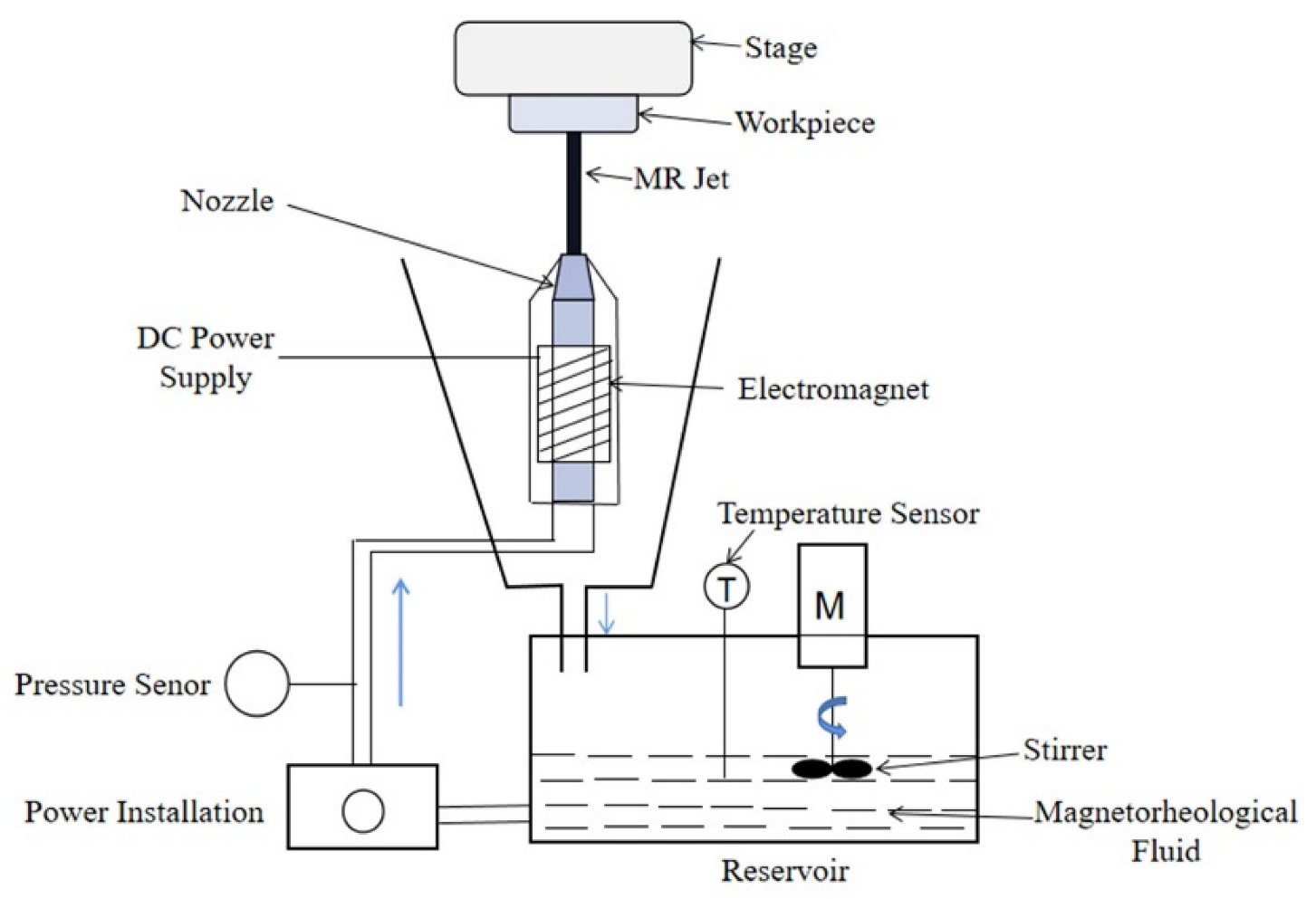
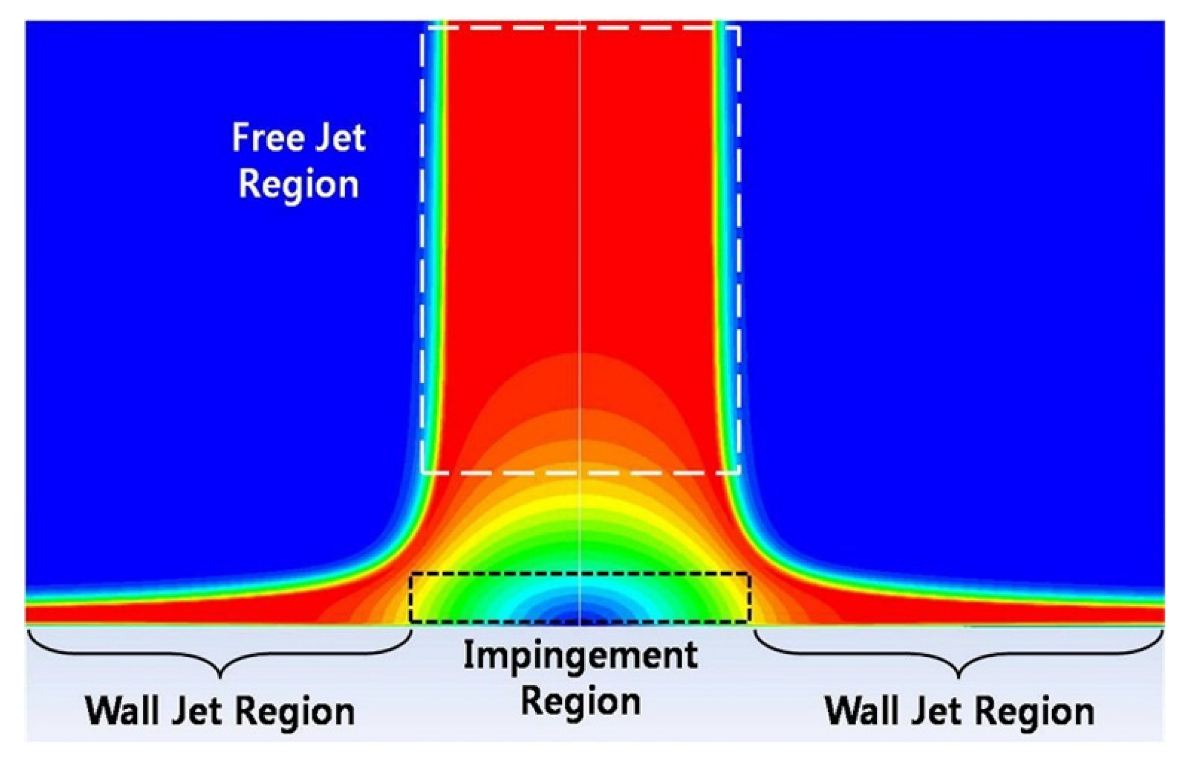

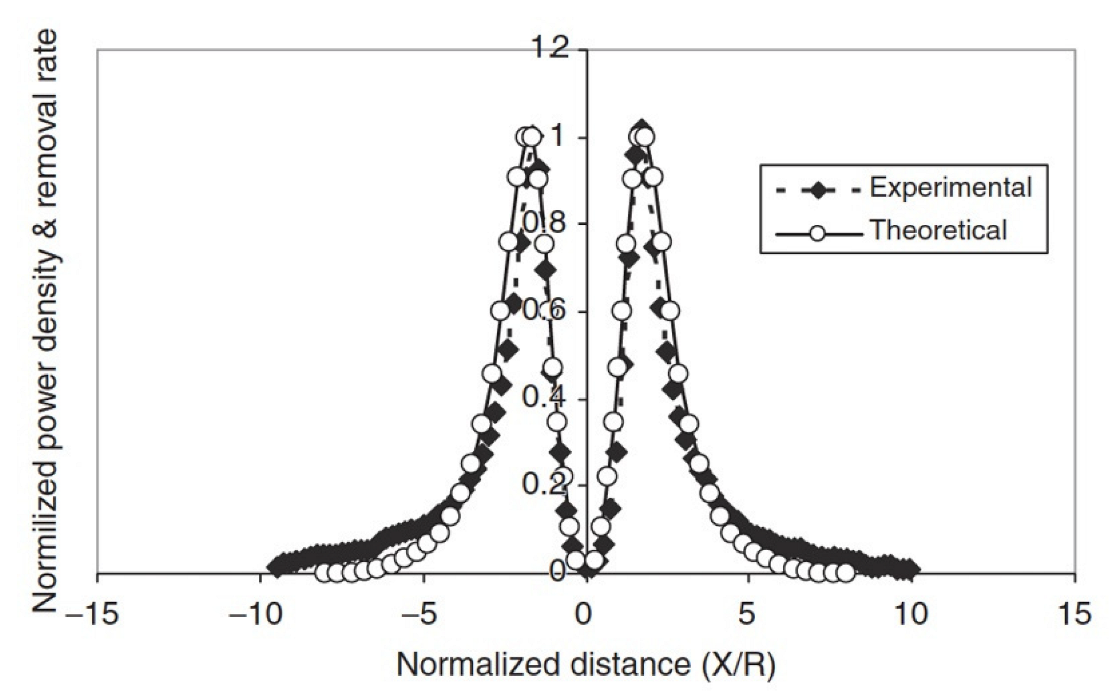
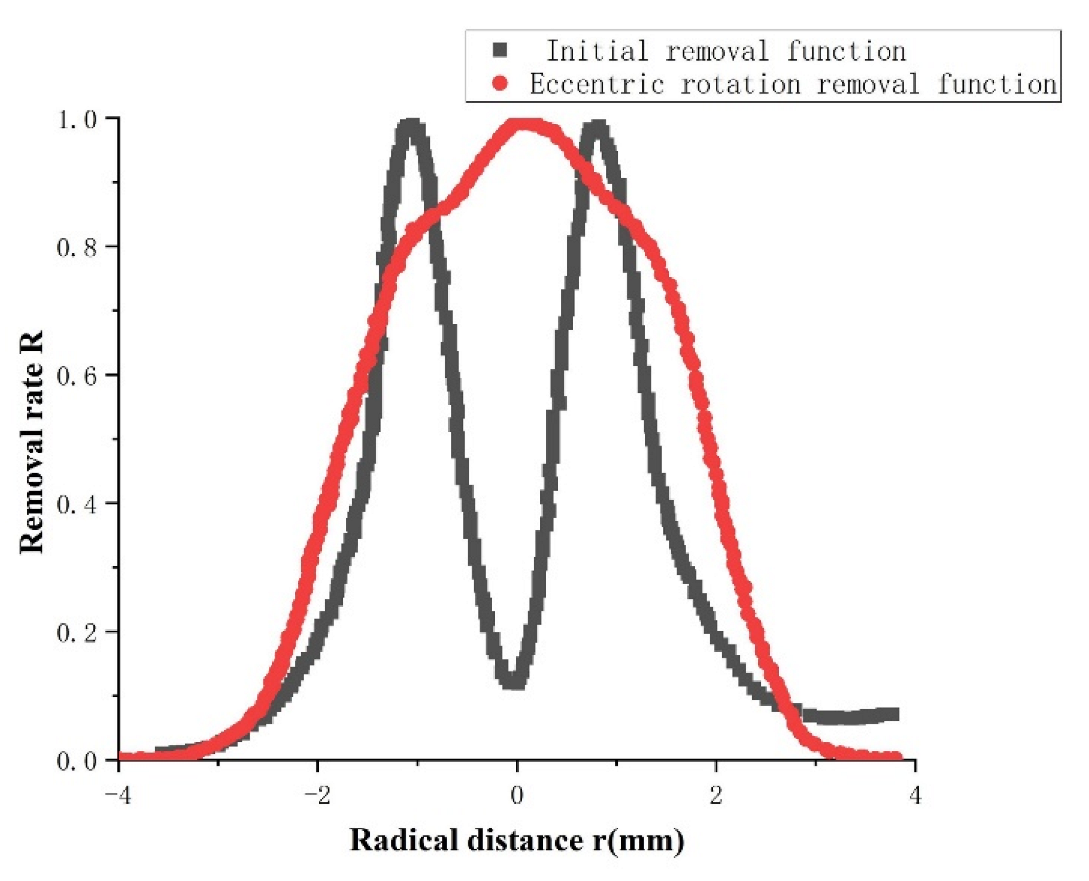
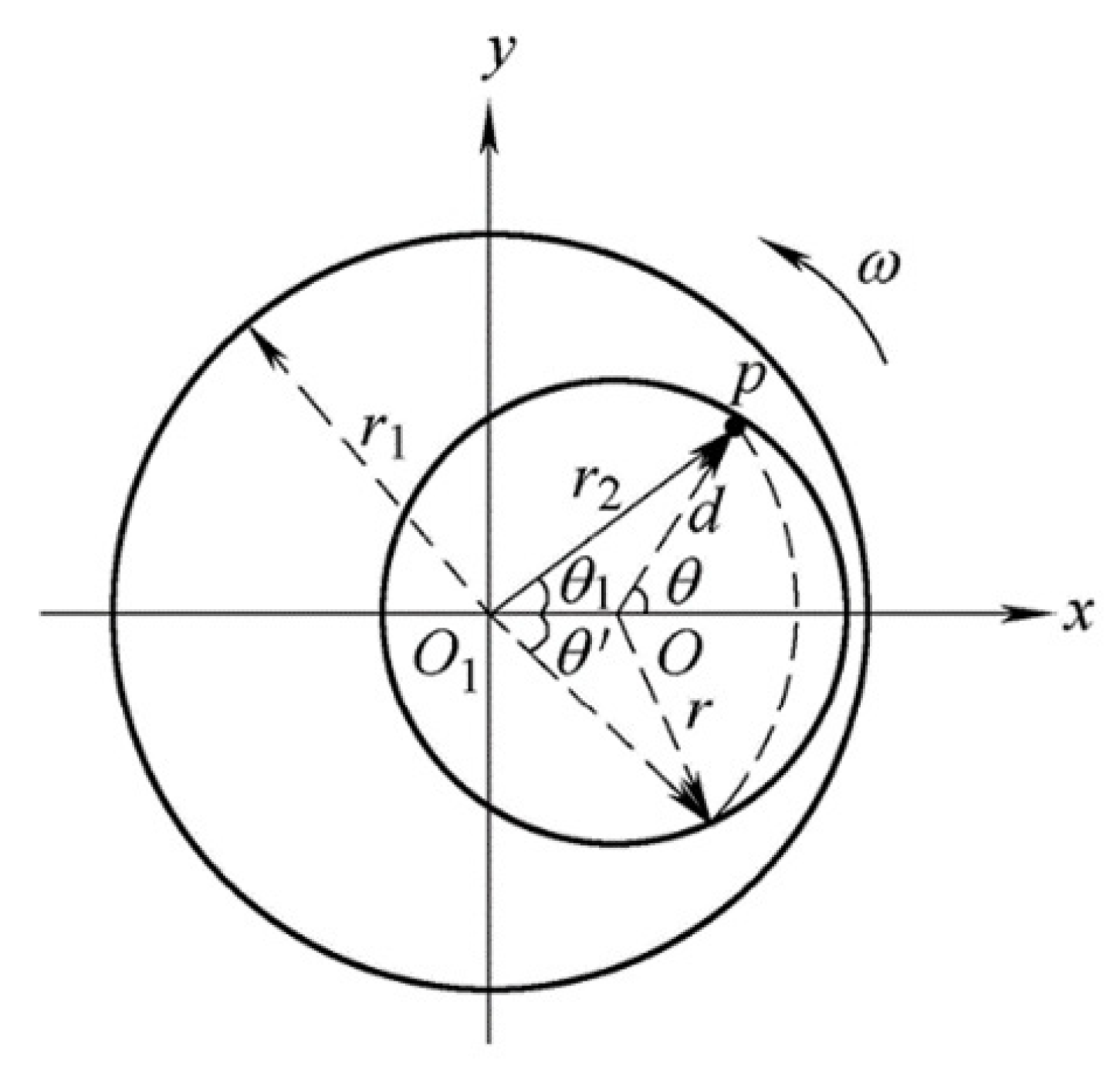
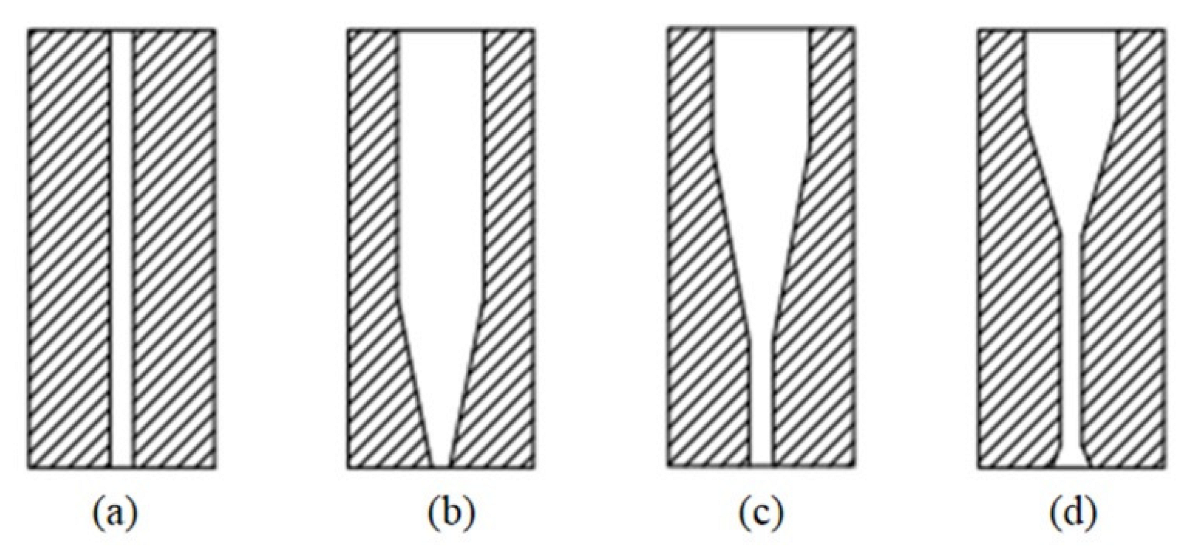

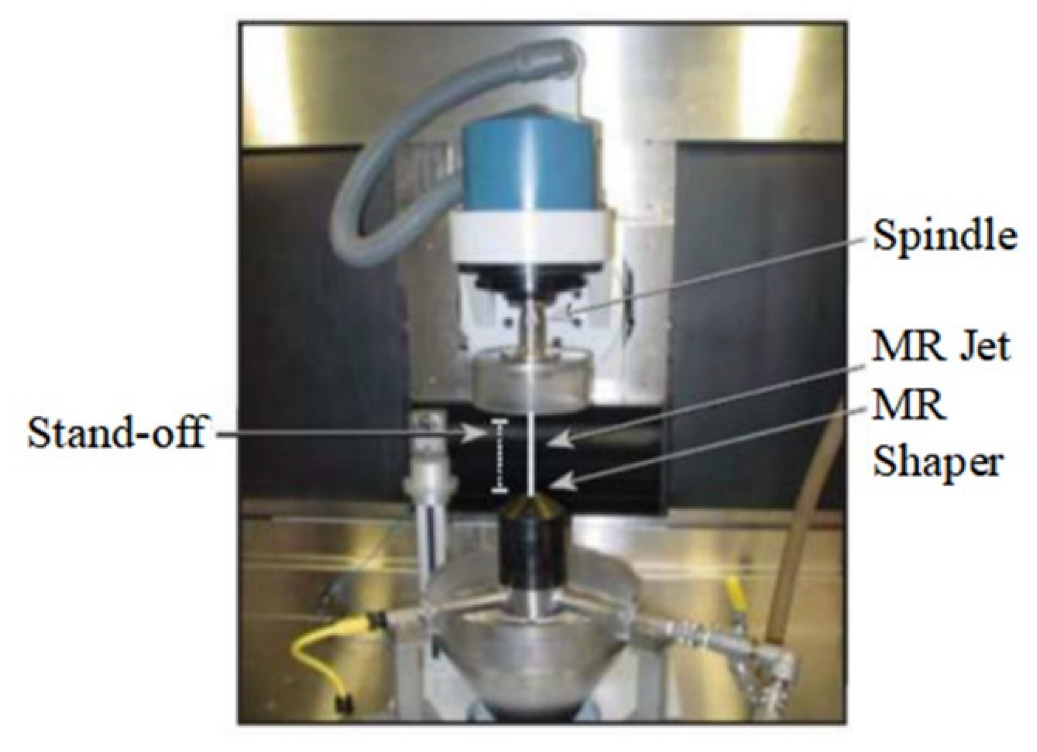
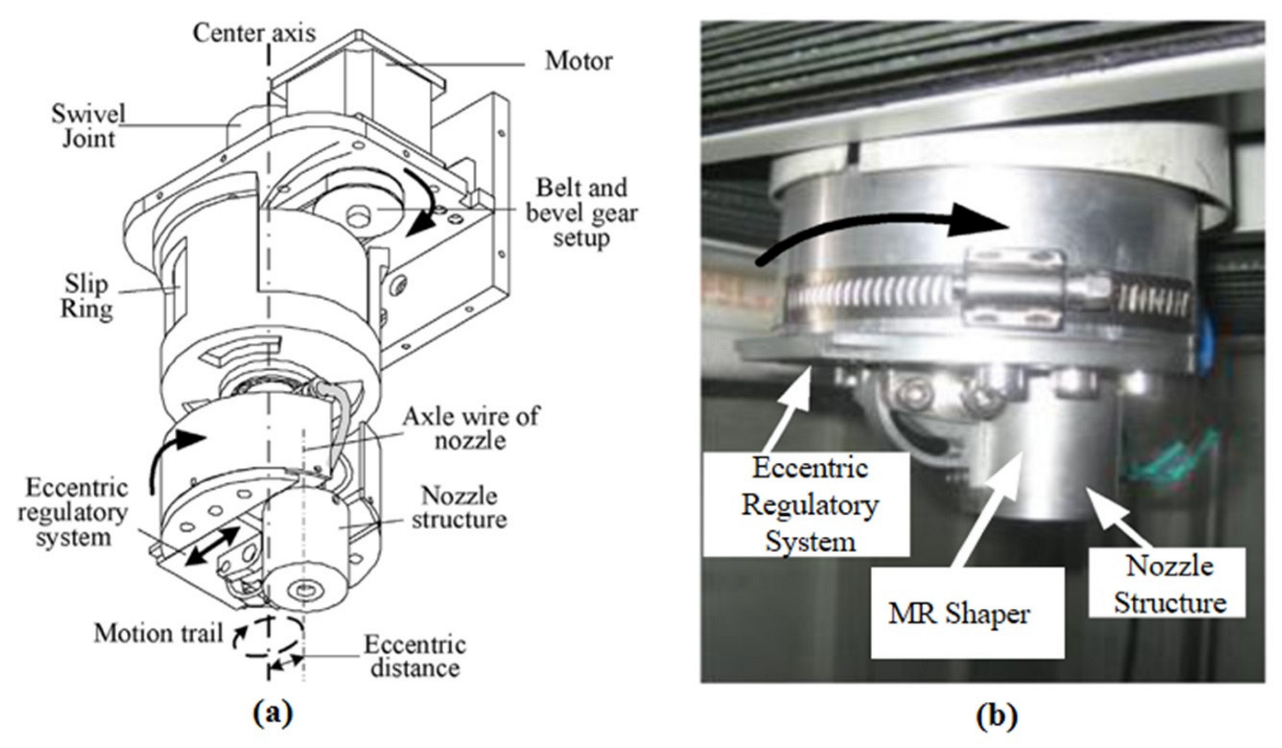
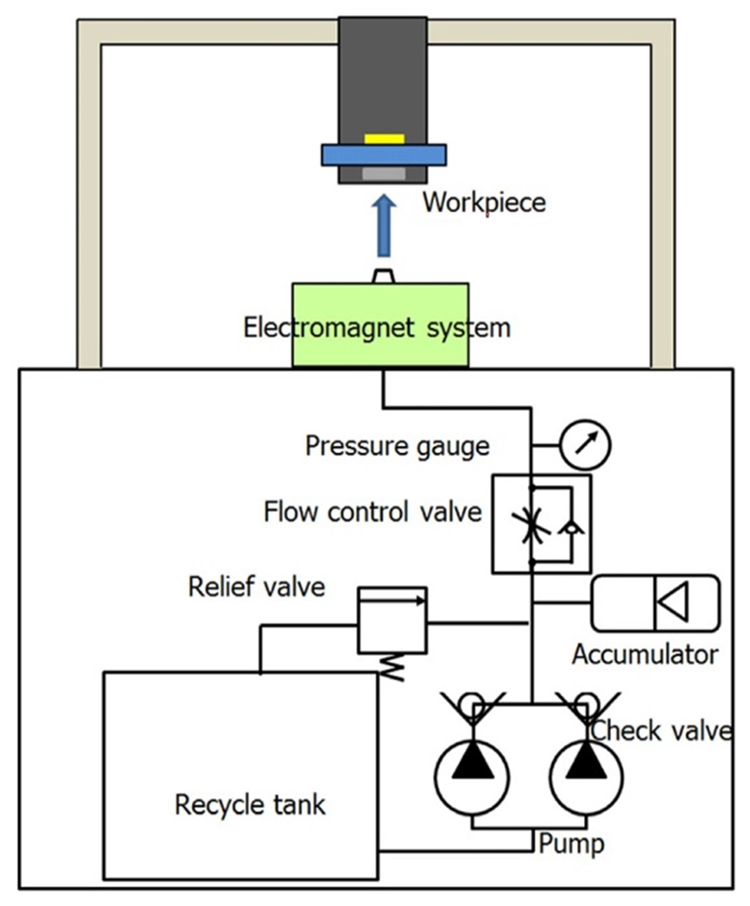

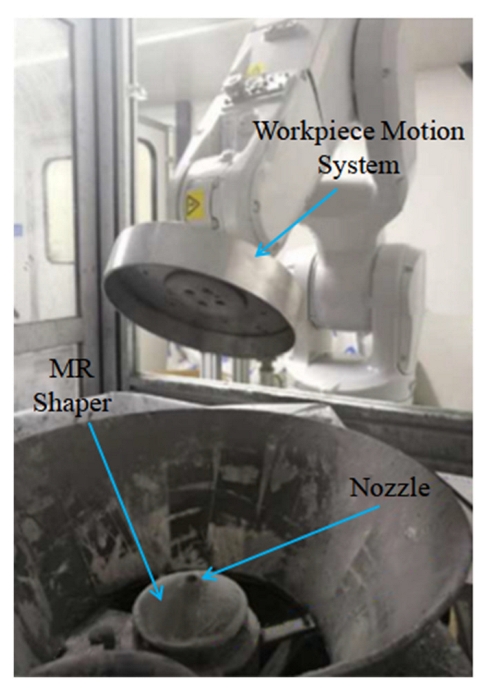
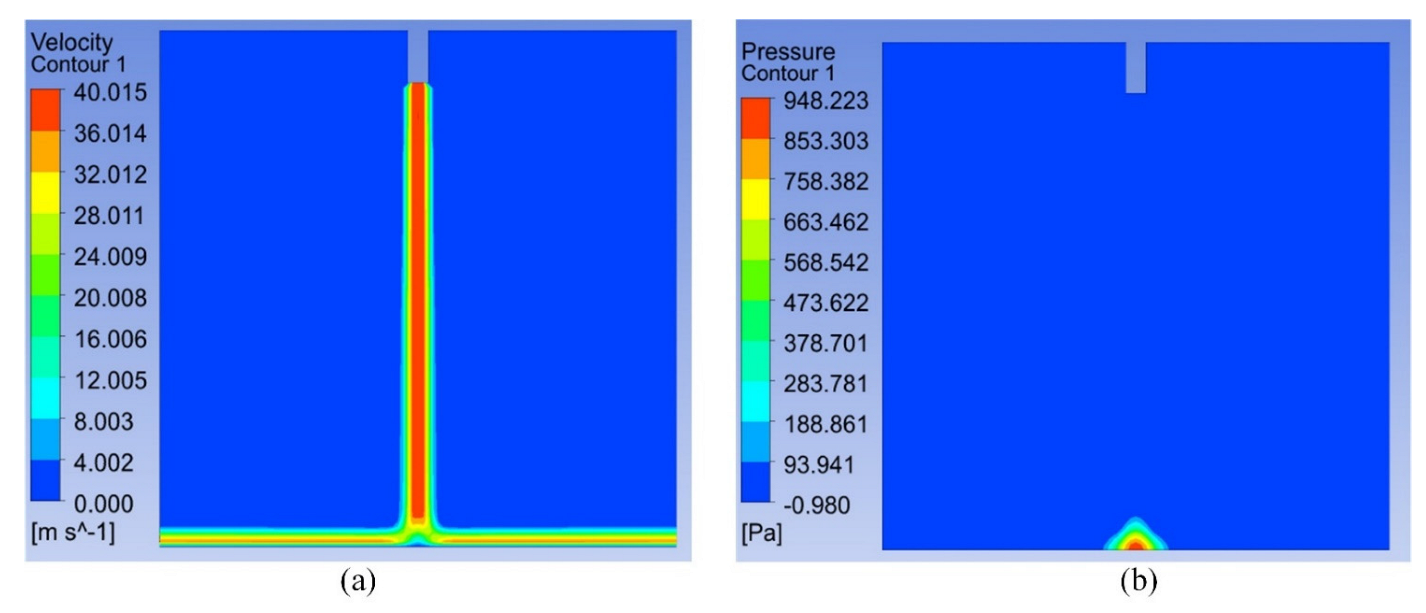
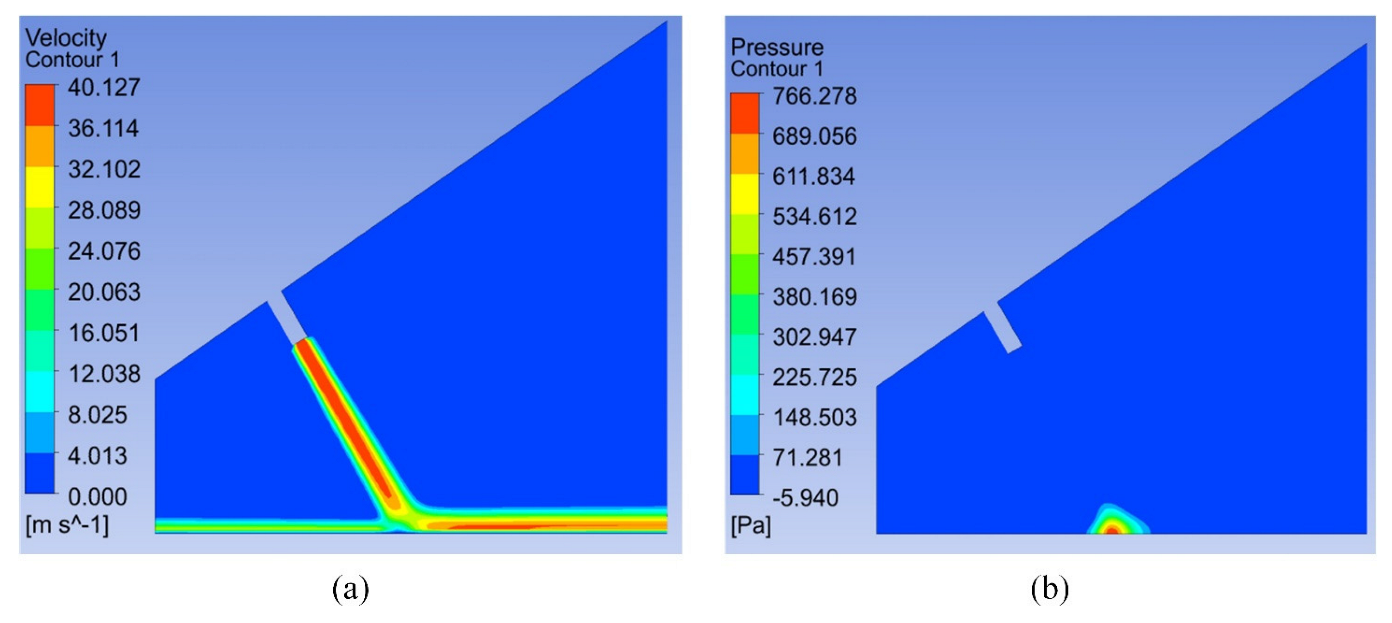
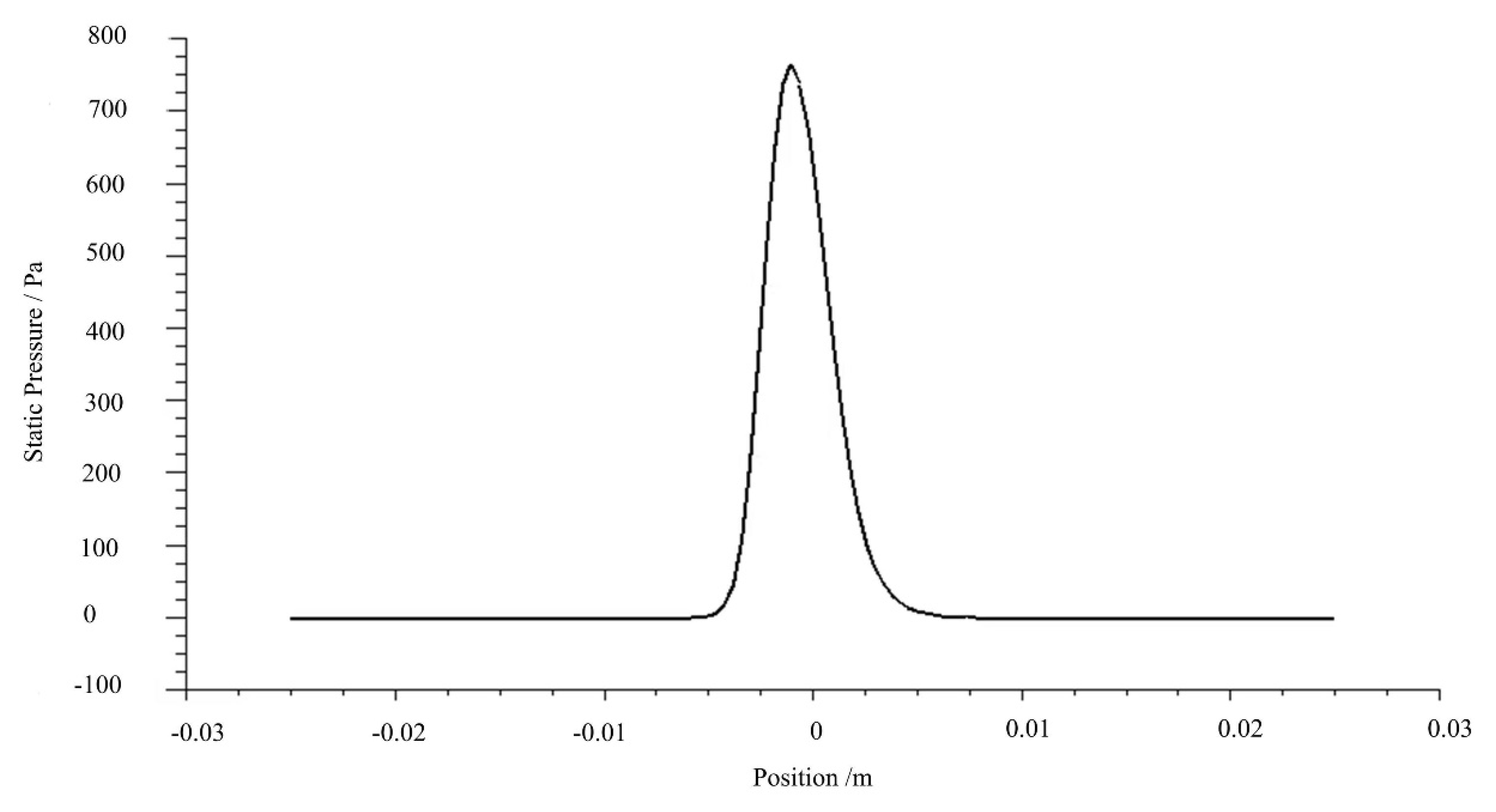
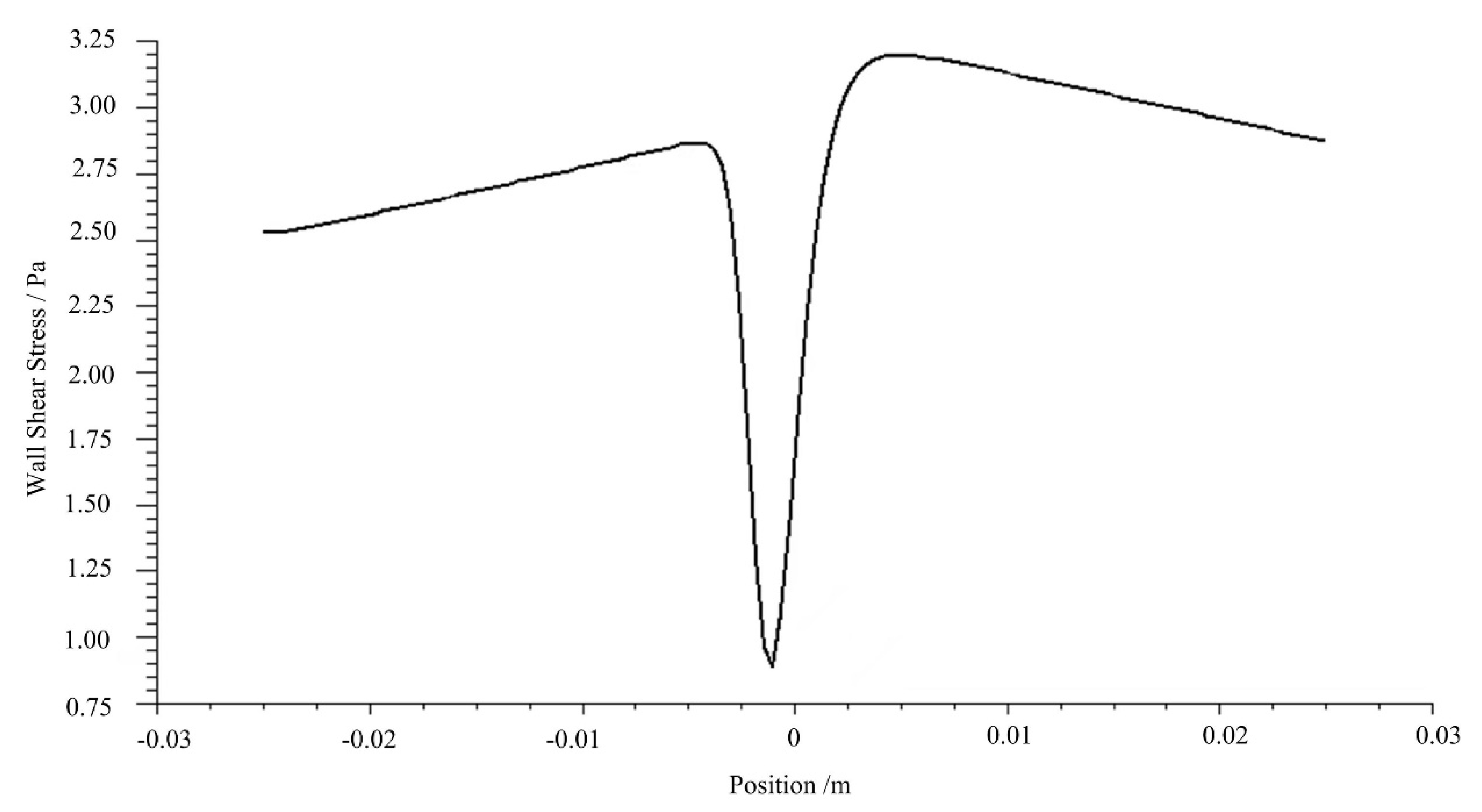
| Parameter | Unit | Data |
|---|---|---|
| Nozzle outlet diameter | mm | 2 |
| The workpiece length | mm | 50 |
| Processing distance | mm | 50 |
| Initial fluid velocity | m·s−1 | 40 |
| The initial pressure | Pa | 101,325 |
| Authors | Work Material | Studies | Data |
|---|---|---|---|
| Zhang et al. [50,63] | K9 glass | PV, RMS | PV: 0.563 to 0.176 μm RMS:0.137 to 0.034 μm |
| Dai et al. [58] | K9 glass | PV | 0.563 to 0.176 μm |
| Wang et al. [95] | K9 glass | PV, RMS | PV: 0.162 to 0.024 μm RMS:0.043 to 0.003 μm |
| Yang et al. [69] | K9 glass | Ra | 4.86 nm |
| Li et al. [96] | BK7 glass | RMS | 40 to 6.8 nm |
| Kim et al. [68] | BK7 glass | RMS | 1.3 nm |
| Kordonski et al. [41] | PCA | PV, RMS | PV: 1740 to 133 nm RMS:255 to 12.1 μm |
| Lu et al. [98] | Steel | Ra | 812 to 88 nm |
| Lee et al. [64,99] | Cu, Ni | Ra | Cu:1.84 nm Ni:2.31 nm |
Publisher’s Note: MDPI stays neutral with regard to jurisdictional claims in published maps and institutional affiliations. |
© 2022 by the authors. Licensee MDPI, Basel, Switzerland. This article is an open access article distributed under the terms and conditions of the Creative Commons Attribution (CC BY) license (https://creativecommons.org/licenses/by/4.0/).
Share and Cite
Song, D.; Du, H.; Lin, J.; Zhou, X.; Wang, R. A Review on Magnetorheological Jet Polishing Technique for Microstructured Functional Surfaces. Lubricants 2022, 10, 237. https://doi.org/10.3390/lubricants10100237
Song D, Du H, Lin J, Zhou X, Wang R. A Review on Magnetorheological Jet Polishing Technique for Microstructured Functional Surfaces. Lubricants. 2022; 10(10):237. https://doi.org/10.3390/lubricants10100237
Chicago/Turabian StyleSong, Dunlan, Hongguang Du, Jieqiong Lin, Xiaoqin Zhou, and Rongqi Wang. 2022. "A Review on Magnetorheological Jet Polishing Technique for Microstructured Functional Surfaces" Lubricants 10, no. 10: 237. https://doi.org/10.3390/lubricants10100237
APA StyleSong, D., Du, H., Lin, J., Zhou, X., & Wang, R. (2022). A Review on Magnetorheological Jet Polishing Technique for Microstructured Functional Surfaces. Lubricants, 10(10), 237. https://doi.org/10.3390/lubricants10100237







